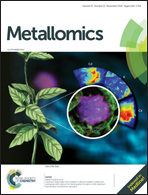Metal binding functions of metallothioneins in the slug Arion vulgaris differ from metal-specific isoforms of terrestrial snails†
Abstract
Arion vulgaris is a land-living European slug belonging to the gastropod clade of Stylommatophora. The species is known as an efficient pest organism in vegetable gardening and horticulture, which may in part be the consequence of its genetically based innate immunity, along with its high ability to withstand toxic metal stress by intracellular detoxification. Like many species of terrestrial snails, slugs possess a distinct capacity for Cd accumulation in their midgut gland, where the metal is stored and inactivated, conferring to these animals an increased metal tolerance. Although midgut gland Cd fractions in slugs have been shown to be variably allocated between different metal-binding protein pools, depending on the level of environmental metal contamination, a true metallothionein (MT) was so far never characterized from slugs. Instead, the Cd binding proteins identified so far were described as Metallothionein-like proteins (MTLPs). In the present study, the slug A. vulgaris was used as a model organism, in order to verify the presence of true MTs in experimentally metal-exposed slugs. We wanted to find out if these suggested slug MTs have similar metal binding properties and metal-selective features like those previously reported from helicid snails. To this aim, two MT isoform genes (AvMT1 and AvMT2) were characterized from midgut gland extracts and localized in the cells of this tissue. The AvMT1 and AvMT2 proteins were purified and partially sequenced, and their metal-binding features analysed after recombinant expression. Eventually, we wanted to understand if and by how much the metal binding features of the two MT isoforms of A. vulgaris may be related, owing to their reciprocal amino acid sequence similarities, to the binding properties of metal-specific MTs from terrestrial snails.

- This article is part of the themed collection: In memory of Silvia Atrian


 Please wait while we load your content...
Please wait while we load your content...